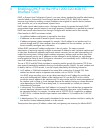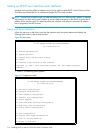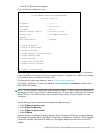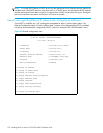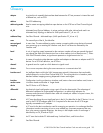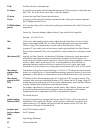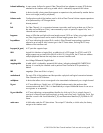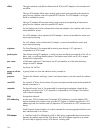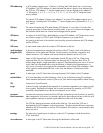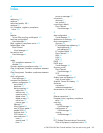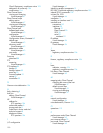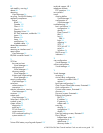e1200-320 4Gb Fibre Channel Interface Card user and service guide 125
indexed addressing A menu name. It allows for generic Fibre Channel host bus adapters to access SCSI devices
attached to the interface card using a table which is indexed by sequential LUN values.
initiator A device (usually a host system) that requests an operation to be performed by another device
known as a target (usually a peripheral).
initiator mode Configuration mode of the interface card in which a Fibre Channel initiator requests operations
to be performed by a SCSI target device.
IP Internet protocol
link For Fibre Channel, it is a connection between two nodes, each having at least one N_Port (or
the other end could be an F-Port), interconnected by a pair of optical or copper links, one
inbound and one outbound.
longwave Lasers or LEDs that emit light with wave lengths around 1300 nm. When using single mode (9
nm) fibre, longwave lasers can be used to achieve lengths greater than 2 km.
loop address A FC term indicating the unique ID of a node in Fibre Channel loop topology, sometimes
referred to as a Loop ID. Also a status type in the FC Status Menu, showing the FC Loop
Address of the interface card.
loop port (nl_port) A FC port that supports loops.
LUN Logical Unit Number or Logical Unit; a subdivision of a SCSI target. For SCSI-2, each SCSI
target supports up to sixteen LUNs (LUN-0 to LUN-15). Using LUNs, the FC host can address
multiple peripheral devices that may share a common interface card.
LVD/SE Low Voltage Differential/Single-Ended
mapping table A table which is indexed by sequential LUN values, indicating selected BUS:TARGET:LUN
devices. It is used by the interface card to perform Fibre Channel-to-SCSI operations by
default.
MB megabyte. (There are 8 bits in a byte.)
motherboard The main PCA of the interface card that provides a physical and logical connection between
Fibre Channel and SCSI devices.
multiplexer A device that allows two or more signals to be transmitted simultaneously on a single channel.
N_port A FC term defining a “Node” port. A FC-defined hardware entity that performs data
communication over the FC link. It is identifiable by a unique Worldwide Name. It can act as
an originator or a responder.
N_port identifier A FC term indicating a unique address identifier by which an N_Port is uniquely known. It
consists of a Domain (most significant byte), an Area, and a Port, each 1 byte long. The N_Port
identifier is used in the Source Identifier (S_ID) and Destination Identifier (D_ID) fields of a FC
frame.
node name A field value under the FC Status Menu. The unique FC identifier, a 64-bit value, the factory
assigns to the interface card.



